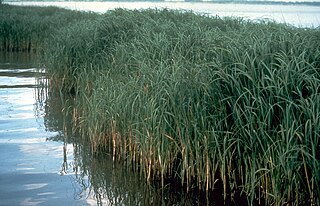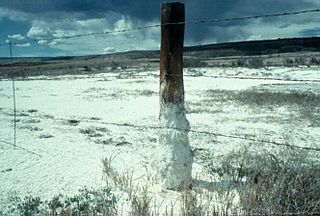Abiotic stress is the negative impact of non-living factors on the living organisms in a specific environment. The non-living variable must influence the environment beyond its normal range of variation to adversely affect the population performance or individual physiology of the organism in a significant way.
Biosalinity is the study and practice of using saline (salty) water for irrigating agricultural crops.
Halotolerance is the adaptation of living organisms to conditions of high salinity. Halotolerant species tend to live in areas such as hypersaline lakes, coastal dunes, saline deserts, salt marshes, and inland salt seas and springs. Halophiles are organisms that live in highly saline environments, and require the salinity to survive, while halotolerant organisms can grow under saline conditions, but do not require elevated concentrations of salt for growth. Halophytes are salt-tolerant higher plants. Halotolerant microorganisms are of considerable biotechnological interest.

A halophyte is a salt-tolerant plant that grows in soil or waters of high salinity, coming into contact with saline water through its roots or by salt spray, such as in saline semi-deserts, mangrove swamps, marshes and sloughs, and seashores. The word derives from Ancient Greek ἅλας (halas) 'salt' and φυτόν (phyton) 'plant'. Halophytes have different anatomy, physiology and biochemistry than glycophytes. An example of a halophyte is the salt marsh grass Spartina alterniflora. Relatively few plant species are halophytes—perhaps only 2% of all plant species. Information about many of the earth's halophytes can be found in the halophyte database.

Soil salinity is the salt content in the soil; the process of increasing the salt content is known as salinization. Salts occur naturally within soils and water. Salination can be caused by natural processes such as mineral weathering or by the gradual withdrawal of an ocean. It can also come about through artificial processes such as irrigation and road salt.
In cellular biology, active transport is the movement of molecules or ions across a cell membrane from a region of lower concentration to a region of higher concentration—against the concentration gradient. Active transport requires cellular energy to achieve this movement. There are two types of active transport: primary active transport that uses adenosine triphosphate (ATP), and secondary active transport that uses an electrochemical gradient. This process is in contrast to passive transport, which allows molecules or ions to move down their concentration gradient, from an area of high concentration to an area of low concentration, without energy.

Cotransporters are a subcategory of membrane transport proteins (transporters) that couple the favorable movement of one molecule with its concentration gradient and unfavorable movement of another molecule against its concentration gradient. They enable coupled or cotransport and include antiporters and symporters. In general, cotransporters consist of two out of the three classes of integral membrane proteins known as transporters that move molecules and ions across biomembranes. Uniporters are also transporters but move only one type of molecule down its concentration gradient and are not classified as cotransporters.

Soil salinity and dryland salinity are two problems degrading the environment of Australia. Salinity is a concern in most states, but especially in the south-west of Western Australia.

Soda inermis, the opposite-leaved saltwort, oppositeleaf Russian thistle, or barilla plant, is a small, annual, succulent shrub that is native to the Mediterranean Basin. It is a halophyte that typically grows in coastal regions and can be irrigated with salt water. The plant was previously classified as Salsola soda, and many of the sources for this article used that designation.
Marshall (Hal) Davidson Hatch AM (born 24 December 1932) was an Australian biochemist and plant physiologist. He was the chief research scientist at the CSIRO Division of Plant Industry in Canberra. He is a Fellow of the Australian Academy of Science, a Fellow of the Royal Society, a Foreign Associate of the US National Academy of Sciences and was awarded Honorary Doctorates from the University of Göttingen and the University of Queensland. In Australia, in 1966, he elucidated, jointly with Charles Roger Slack, the C4 pathway for the fixation of carbon, which is also sometimes known as the Hatch-Slack pathway. He is now retired.
William James Peacock, is an Australian molecular biologist who was Chief Scientist of Australia (2006–2008), President of the Australian Academy of Science (2002–2006) and Chief of CSIRO Plant Industry (1978–2003).
Ralph Owen Slatyer was an Australian ecologist, and the first Chief Scientist of Australia from 1989 to 1992.

Nagendra Kumar Singh is an Indian agricultural scientist. He is presently a National Professor Dr. B.P. Pal Chair and JC Bose National Fellow at ICAR-National Institute for Plant Biotechnology, Indian Agricultural Research Institute, New Delhi. He was born in a small village Rajapur in the Mau District of Uttar Pradesh, India. He is known for his research in the area of plant genomics, genetics, molecular breeding and biotechnology, particularly for his contribution in the decoding of rice, tomato, wheat, pigeon pea, jute and mango genomes and understanding of wheat seed storage proteins and their effect on wheat quality. He has made significant advances in comparative analysis of rice and wheat genomes and mapping of genes for yield, salt tolerance and basmati quality traits in rice. He is one of the highest cited agricultural scientists from India for the last five years.

Zeba Islam Seraj is a Bangladeshi scientist known for her research in developing salt-tolerant rice varieties suitable for growth in the coastal areas of Bangladesh. She is currently a professor at the Department of Biochemistry and Molecular Biology, University of Dhaka.
Elizabeth Salisbury Dennis is an Australian scientist working mainly in the area of plant molecular biology. She is currently a chief scientist at the plant division of CSIRO Canberra. She was elected a Fellow of the Australian Academy of Technological Sciences and Engineering (FTSE) in 1987, and the Australian Academy of Science in 1995. She jointly received the inaugural Prime Minister's Science Prize together with Professor Jim Peacock in 2000 for her outstanding achievements in science and technology.
Katherine Wilson is a molecular biologist and a marine scientist. She is also the executive director of the science division at the Office of Environment and Heritage (OEH), New South Wales. Wilson is responsible for the delivery of OEH's science program, which provides technical analysis, expert advice and research to support the NSW government's policy and program objectives in environmental management. As a member of the OEH Executive, Wilson guides delivery of services ranging from energy efficiency programs to management of national parks. Wilson is also a Board Member of the Low Carbon Living Cooperative Research Centre and Chair of the External Advisory Committee, Australian Rivers and Wetlands Centre, University of New South Wales.
As a model organism, the Arabidopsis thaliana response to salinity is studied to aid understanding of other more economically important crops.
Anna Amtmann is a German scientist. She is professor for Molecular Plant Physiology at the University of Glasgow. She serves as Editor-in-Chief of the journal Plant, Cell & Environment.
Julian I. Schroeder is an American biologist. He is a Distinguished Professor and Novartis Chair at the University of California, San Diego. Schroeder's research involves identifying the basic molecular mechanisms by which plants respond to and mount resistance to environmental stresses, with a focus on drought, salinity, and the rising atmospheric CO2 concentration.
Neil Clifford Turner is an Australian agricultural scientist known for his contributions to agronomy and crop physiology, particularly in the adaptation of crops to dry lands. He was the recipient of the Humboldt Research Award and the Centenary Medal for service to Australian society in environmental science. He is a member of the Order of Australia and his contributions spans physiological response of crops and trees to water deficits, rainfall-use efficiency, climate change implications for crop production, and various abiotic and biotic stress factors affecting plant growth and productivity.






